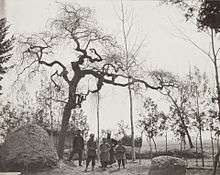Ulmus pumila 'Pendula'
| Ulmus pumila | |
|---|---|
 U. pumila 'Pendula', Fengtai, 1908 | |
| Cultivar | 'Pendula' |
| Origin | China |
The Siberian Elm cultivar Ulmus pumila 'Pendula' from northern China was classified by Frank Meyer in 1908,[1] and confirmed as an U. pumila cultivar by Krüssmann in Handbuch der Laubgehölze 2: 540. 1962. The USDA plant inventory record (1916) noted that it was a "rare variety even in China".[2]
Late 19th-century herbarium leaf-specimens suggest that the epithet 'Pendula' has been attached to other forms of Siberian elm.[3]
Description
The tree was described as having pendulous branches bearing small leaves with equal teeth.[4] Frank Meyer's early 20th-century clone from China (see 'Cultivation', below) is a straggling tree with twisting, often level boughs with occasional tangled branch-ends, in branching more like Weeping Ash than the other weeping elms, and with long pendulous pinnate branchlets, like stouter versions of the Turkestan Elm.[5][6][7]
.jpg) 'Weeping Chinese Elm' (U. pumila 'Pendula'), Royal Crescent, Edinburgh (2016)
'Weeping Chinese Elm' (U. pumila 'Pendula'), Royal Crescent, Edinburgh (2016).jpg) Same tree
Same tree Leaves of 'Weeping Chinese Elm' (U. pumila 'Pendula'), August
Leaves of 'Weeping Chinese Elm' (U. pumila 'Pendula'), August
Pests and diseases
See under Ulmus pumila.
Cultivation
Meyer's elm is still cultivated in China, where it is known as Lung chao yü shu (: Dragon's-claw elm);[8] its asymmetrical, contorted habit is clear even in young specimens.[9][10][11] It is more rarely cultivated in Europe and North America; the clone from Fengtai introduced to the USA by Meyer as Weeping Chinese Elm is said to have been "widely distributed" in the northwestern States.[12] The tree probably survives in the Longenecker Horticultural Gardens, University of Wisconsin,[13] however all the specimens grown at the Morton Arboretum, Illinois, obtained in the 1950s had either died or been felled by 2008 because of their poor condition.
.jpg)
Standards supplied in the West today as U. pumila 'Pendula' appear to be a more symmetrical and neatly shaped clone than Meyer's.[14] The name 'Weeping Chinese Elm' is now sometimes used for Ulmus parvifolia 'Sempervirens', a cultivar of the true Chinese Elm.
Notable trees
.jpg)
Old examples of 'Pendula', resembling Meyer's 1908 photograph of a mature specimen in Fengtai,[15] survive in Edinburgh (2016). The largest (height 12 m, girth over 2 m), presumably the UK champion, overlooks Ferry Road Path, between 7 and 9 Rosebank Rd.[16] Two others stand at the intersection of Royal Crescent and Dundonald St and at 47 York Rd.[17] There are trees of the same type opposite the Rosebank Rd elm on the other side of Ferry Road Path.
A probable example grows at the Friston Forest car park in East Sussex, England; cloned in 2011, a specimen is now under analysis at the Royal Botanic Gardens Kew.
Synonymy
- Ulmus campestris (: minor) pendula: David, Revue horticole II. 4: 101. 1845.
- Ulmus sibirica Hort.: Lavallée,[18] Arboretum Segrezianum 237, 1877, in synonymy.
- Ulmus pumila Linn. cv. 'Pendula' Kirchner.
Nurseries
Europe
References
| Wikimedia Commons has media related to Ulmus pumila. |
- ↑ Photograph by Frank Nicholas Meyer of 'Pendula' in Fengtai, via.lib.harvard.edu
- ↑ Variety Conservation Group, 'Missing or confused cultivars'
- ↑ elmer.rbge.org.uk,
- ↑ Green, Peter Shaw (1964). "Registration of cultivar names in Ulmus" (PDF). Arnoldia. Arnold Arboretum, Harvard University. 24 (6–8): 41–80. Retrieved 20 June 2016.
- ↑ Variety Conservation Group, 'Missing or confused cultivars'
- ↑ Stout branchlets of Meyer's clone in his 1915 photograph of a specimen in the Peking Botanic Garden.
- ↑ Ulmus/Meyer (photo 8, 24 April 1915)
- ↑ 'Inventory of Seeds and Plants Imported ... April–June 1915' (March 1918), ars-grin.gov/npgs/pi_books/scans/pi043.pdf
- ↑ Ulmus pumila 'Pendula' in China, zhiwutong.com Other Ulmus pumila 'Pendula' in China, zhiwutong.com
- ↑ Photograph by Meyer of 'Pendula' in Fengtai, via.lib.harvard.edu
- ↑ "中国自然标本馆". Cfh.ac.cn. Retrieved 2013-08-30.
- ↑ Variety Conservation Group, 'Missing or confused cultivars'
- ↑ 'Pendula' in Longenecker Horticultural Gardens: "Ulmus pumila 'Pendula' habit: hort.net photo gallery" Check
|url=value (help). Hort.net. Retrieved 2013-08-30. - ↑ 'Weeping Siberian Elm', plants.gardensupplyco.com
- ↑ Ulmus/Meyer (photo 12, 27 Feb. 1908)
- ↑ Google Maps: Rosebank Rd - Google Maps, accessdate: August 30, 2016
- ↑ The York Rd & Royal Crescent elms may be seen on Google Streetview.
- ↑ http://kiki.huh.harvard.edu/databases/botanist_search.php?id=353